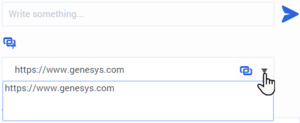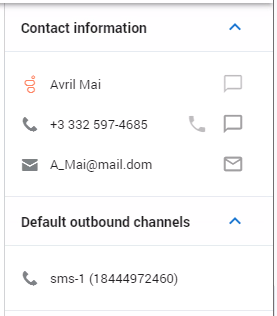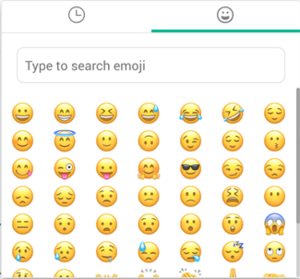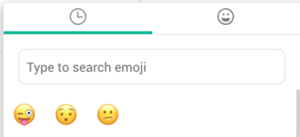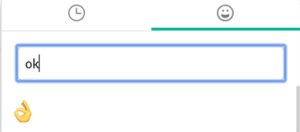Chat
Chat is a Genesys Digital channel. The chat channel lets you handle customer chats. To chat with your team members start a chat consultation.
This page describes the typical options for handling a chat interaction. During a chat session, you and your contact send messages back and forth in real-time. When your contact is typing, you will see a notice that they are writing a response, but you won't see what they have written until they send it. The Interaction View keeps track of the conversation and allows you to review what has been said. Chat interactions include Web Chat, Facebook Messenger, Twitter Direct Messages, WhatsApp messages, and SMS.
In most cases, the chat interaction is directed to your desktop, you exchange messages, and when either you or the contact ends the chat session, the interaction is ended and must be closed and marked as Done. However, sometimes you need to continue a chat conversation. Perhaps you had to take time to find additional information for the contact or initiate a business process in your company before continuing the conversation.
Contents
How do I handle a chat interaction?
When you accept a chat request, the name of the contact is displayed at the top of the screen and the timer for the pending response indicator starts. The color of the indicator begins as green, then changes to yellow if you have not responded within the specified time limit. If you still do not respond, the indicator changes to red and begins to flash.
Some of the things you can do while handling a chat include:
- Transfer (
 ) the chat to someone else in your company.
) the chat to someone else in your company. - Start a chat conference (
 ) with yourself, the customer, and someone else in your company.
) with yourself, the customer, and someone else in your company. - Start a Voice (internal targets and contacts) or Chat (an internal target only) consultation. If you want to perform a warm transfer or a two-step transfer, click Consult to talk to the consultation target and then click Transfer to transfer the call.
- Call or email the contact, if there is a phone number or email address in the contact database. (You can also launch a call or email from the Party Action menu by clicking an email address or phone number.) If your account is set up for it, you can also click a phone number or email address that your contact sends you as a chat message to call or email the contact.
- Add a disposition code or note.
- End the chat (
 ) and mark it as done (
) and mark it as done ( ).
).
If you place your mouse pointer over the interaction in the Interaction Bar, you can see the elapsed time of the interaction and the last lines of the chat transcript. Connection-status information is displayed next to theParty Action menu.
Note: If you have a pending response and the Chat Interaction window is not the active window, it will start flashing in the Windows taskbar, regardless of the pending-response indicator status (green, yellow, or red).
Watch the video to see what happens when a chat request arrives at a workstation.
Pushing weblinks (URLs) to your contacts
Some agents might be set up to push website links (URLs) to contacts. If you are, you will see the Add URL button (![]() ) beneath the chat text editing area.
) beneath the chat text editing area.
Click the button to open the URL Editor below the chat text editing area. Type or paste the website address (URL) that you want to send to your contact and click Send (![]() ).
).
To check the URL before you sent it, click the link symbol (![]() ) to open the URL in your browser. This way you can be sure that you are sending your contact to the correct website.
) to open the URL in your browser. This way you can be sure that you are sending your contact to the correct website.
If you have sent previous URLs, a down arrow is displayed next to the link symbol in the URL Editor area. Click the arrow to open a menu that contains a list of URLs that you have sent to your contacts. Select one of the URLs to push it to your contact. You can use arrow keys to navigate through the list of URLs: up and down highlights the next URL, left or right selects it and inserts it into the Push URL field.
Your contact will receive a message in their chat window telling them to click the link that you sent them.
Send Emojis to Contacts
Your account might be set up to let you send emojis (emoticons or smileys) to your contact as part of the chat interaction text. Emojis are little faces and other symbols that you can use to let your contact know how you are feeling or to help them to know when something is good, funny, bad, or sad. Ask your supervisor or administrator about when to use emojis.
The Communication tab uses a different emoji picker from the Chat interaction view.
There are different ways to add emojis to your chats. Some contact centers allow you to copy and paste emojis into the text editing area. Other contact centers might have the Emoji Picker enabled (see below) — use this tool to choose an emoji to send.
Your administrator might have enabled the licensed emojis that come with Workspace Agent Desktop. These are pictures that enhance the appearance of standard operating system and browser supported emojis. If this feature is not enabled for you, you will see the standard color or black and white emojis that are supported by your operating system and browser instead.
Use the Emoji Picker to add an emoji to your chat interaction:
- Click the Choose an emoji button (
 ) that appears below the text editing area to display the menu of emojis that you can choose from.
) that appears below the text editing area to display the menu of emojis that you can choose from.
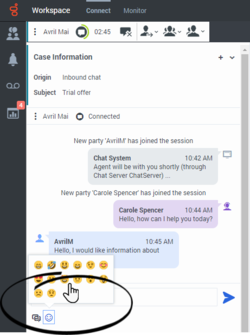
- Click an emoji.
- Click Send (
 ).
).
Continuing the conversation
If your account is enabled for asynchronous chat, you can continue a chat interaction after the initial interaction is ended by using the Conversation tab in the interaction window or the Communication tab.
If you have not yet marked a closed interaction as Done, in the Conversation tab, the transcript of your current interaction as well as all previous chat interactions with the contact is displayed. You can scroll through it or use the Search feature to find messages containing keywords. To reactivate the Chat session, type your message in the Message field and click Send.
If you want to reactivate an interaction that is already closed and marked as Done, in the Connect group, select the Communication tab, open the Contact panel and select the contact. All previous Chat interactions that your contact center has had with the contact are displayed in the transcript area on the right. To reactivate the chat session, click the Chat button in the Contact info column to open the Chat interaction view.
Conversation tab
If Asynchronous Chat is enabled for your account, the Conversation tab is displayed in the right panel of the Chat Interaction view.
To receive chat interactions, set your status on the Chat channel to Ready.
Click Accept when a chat notification arrives on your desktop. This opens the Chat Interaction view. Handle the Chat interaction as normal. The transcript of the chat is displayed both in the Transcript area and the Conversation tab. The Conversation tab also contains the transcripts of all previous chat interactions that your contact center has had with the contact.
The Conversation tab allows the following actions:
 : Click to refresh the conversation display.
: Click to refresh the conversation display. : Click to send messages you type in the Message Composition area.
: Click to send messages you type in the Message Composition area. : Attach an image.
: Attach an image. : Send an emoji to your contact.
: Send an emoji to your contact.
If you or the contact end the session, you can keep the Chat interaction view open while you perform other actions or business processes. Check with your supervisor about whether to mark the interaction as Done or keep the interaction view open while you perform other duties.
Keeping the interaction view active might affect your Ready status.
Communication tab
The Communication tab in the Connect group lets you continue chat conversations that you or others at your contact center have had with your company's contacts.
After an agent or the contact leaves a chat session, you can continue the conversation by finding the contact in the Communication tab and selecting their name from the contact list.
To continue the conversation, either type in the Write a Message field and click Send or click the Chat icon to open a new Chat interaction view.
If you are unsure whether the contact still has the browser open where they initiated the previous chat, use the Write a Message field in the Communication tab. The next time that the contact logs in to your company's website the chat will continue and the contact will see all the new and previous messages.
When the contact responds, you receive a notification on your desktop. Click Show to open the Communication tab of the Connect group. Click the Chat icon to open the chat in a new Chat interaction view if you need to respond and continue the conversation.
The Communication tab has two areas, the Contacts list and the conversation transcript area.
- Select a contact in the Contacts list to see the conversations that contact has had with with your company. If a contact is currently active on a channel, a white dot is displayed next to their name.
- Choose Private to see Web Chat, Facebook Messenger, and Twitter Direct Messages transcripts.
- Choose Public to see public Facebook messages and Twitter Tweets that involve your company.
- The conversation transcript area displays all the chat interactions that the selected contact has had with your company.
The conversation area allows the following actions:
 : Click to send messages you type in the Message Composition area.
: Click to send messages you type in the Message Composition area. : Attach an image.
: Attach an image. : Send an emoji to your contact.
: Send an emoji to your contact. : Toggle the display of the Contacts list area.
: Toggle the display of the Contacts list area.
To launch an interaction, such as a chat or an SMS, click the interaction type in the Contact info column. This launches the Chat Interaction window and enables you to continue the conversation there with access to all the interaction window features such as Contact Information, Contact History, and Standard Responses. Note: Genesys recommends that you switch to a chat interaction window whenever you want your chatting time to be recorded for KPI purposes.
Using the Communication Tab Emoji Picker
The emoji picker lets you select an emoji to insert into your message from either the Chat interaction (including social media and other messaging channels such as SMS and WhatsApp), the Conversation tab, or the Communication tab. To open the emoji picker, click the Emoji button ![]() . To insert an emoji into the message composition field, click it.
. To insert an emoji into the message composition field, click it.
There are two views in the emoji picker, Recent and All:
 : Click to see your recently used emojis.
: Click to see your recently used emojis. : Click to see all of the available emojis.
: Click to see all of the available emojis.
The Recent view lets you pick from among the last XX emojis that you have sent. This is handy if you have favorite emojis that you like to use over and over.
You can search for emojis by name using the search field. Type in the name of an emoji or sentiment.

